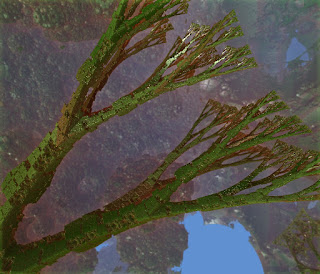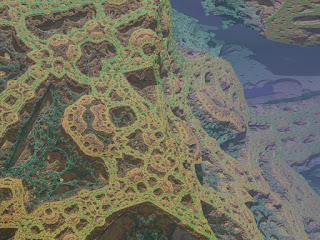I have added images on occasion to fractalforums.com, however since this is being moved to fractalforums.org, these images might get lost, so I am storing them and presenting them here, in roughly chronological order.
This is a set of random ideas that just want to jump out of my head and onto the internet. Who knows whether office chair philosophy is any more credible than arm chair philosophy, but you decide, and let me know.
Sunday, October 22, 2017
Saturday, September 2, 2017
Complex Dimensional Geometry
I previously introduced the signed-dimension which generalised fractal geometry to negative dimensions. Is it possible to further generalise to complex dimensional geometry? In other words could we assign a complex value to the dimension of a set in some N dimension space?
What would it look like?
Let's say we have a large extents viewing window and a small cell size, so we have a large and fixed resolution of 'pixels' within the view window. Now we count the occupied cells as we zoom in.
We know from this previous post that for positive dimension sets the count will grow and for negative sets it will shrink. So for an imaginary dimension set we should expect it to neither shrink nor grow, but oscillate. For a complex dimension we expect it to grow according to the real part of the dimension, and oscillate at a rate according to the imaginary part.
To extract the sinusoidal growth pattern from the data you cannot just look at behaviour at a scale extreme, but instead look at the count across all scales. Firstly we need to make the signed dimension more robust to the inclusion of oscillations:
Secondly we need to extract those oscillations, which give the imaginary dimension:
This represents the rate of oscillation as you zoom in. If the signed-dimension is a and the imaginary dimension is b then the shape is a + bi dimensional. However, since the count can never be negative the shape must also include an a dimensional component, and since the count can never be imaginary, the shape must also include an a-bi dimensional component. This means the shape is multi-fractal. If we were to measure it in standard units then we would say that its size is k1 metres^a + k2 metres^(a+bi) + k2 metres^(a-bi) for some values k1, k2 which are fractal measures.
Acknowledging this necessary multifractal nature, we can give its complex dimension as:
More details are given here.
EDIT
I have recently discovered a good sized body of work on complex dimensional geometry, mainly by Michael Lapidus: https://link.springer.com/book/10.1007%2F978-0-387-35208-4
which extends from roughly 2005 to the present.
For some reason this work focuses on 'fractal strings' which are sets of strings (line segments that are fixed at their ends, so theoretically can vibrate at divisors of this wavelength).
Never-the-less you can convert to fractals by just looking at their end points, or by thinking of subsequent sizes as one iteration each, leaving the fractal at the limit.
Anyway, their conclusion is very similar to my own. Basically the fractal measure oscillates with scale, and this oscillation can be captured by multiple sine waves, giving multiple complex dimensions per fractal. Often the main oscillation is enough, especially since 'lattice fractals' (those with simple self-similarity) have their dimensions in a regular vertical stack, so the first element is most informative. As with my conclusion, each complex number includes its conjugate so the sum of the complex dimensions is real.
The piece that this work is missing is a mechanism for negative dimensional fractals.
What would it look like?
Let's say we have a large extents viewing window and a small cell size, so we have a large and fixed resolution of 'pixels' within the view window. Now we count the occupied cells as we zoom in.
We know from this previous post that for positive dimension sets the count will grow and for negative sets it will shrink. So for an imaginary dimension set we should expect it to neither shrink nor grow, but oscillate. For a complex dimension we expect it to grow according to the real part of the dimension, and oscillate at a rate according to the imaginary part.
(a) counting cells for a line as we halve cell size: 1, 2, 4, ..
(b) same growth as above. It doesn't have to be a curve to have dimension 1
(c) this shape has same growth rate, but with an oscillation: 1, 4, 4, 16, 16, 64, 64,..
Above (c) shows a shape that is on average one dimensional, but oscillates relative to the growth. The oscillation repeats each time we divide cell size by 4, this suggests the imaginary component of the dimension should be 2pi/ln(4), which is about 4.53i. As described in the previous post, (c)'s dimension has a positive real part if it is finite size, or a zero real part if it is infinite in extent. In the latter case, it is a purely imaginary dimensional shape. Here are two other examples:
3x3 dust is 2.86i dimensional:
5x5 dust is 1.95i dimensional:
The moving graph shows plots the point count in the view window. Changing the view window size adjusts the shape but not the period of the graph. As you can see the fractals with smaller imaginary dimension are spatially more sparse, which suggests that the imaginary dimension could have a similar role to lacunarity as a description of sparseness, to accompany the fractal dimension.
To extract the sinusoidal growth pattern from the data you cannot just look at behaviour at a scale extreme, but instead look at the count across all scales. Firstly we need to make the signed dimension more robust to the inclusion of oscillations:
so the signed dimension is:
Secondly we need to extract those oscillations, which give the imaginary dimension:
Acknowledging this necessary multifractal nature, we can give its complex dimension as:
More details are given here.
EDIT
I have recently discovered a good sized body of work on complex dimensional geometry, mainly by Michael Lapidus: https://link.springer.com/book/10.1007%2F978-0-387-35208-4
which extends from roughly 2005 to the present.
For some reason this work focuses on 'fractal strings' which are sets of strings (line segments that are fixed at their ends, so theoretically can vibrate at divisors of this wavelength).
Never-the-less you can convert to fractals by just looking at their end points, or by thinking of subsequent sizes as one iteration each, leaving the fractal at the limit.
Anyway, their conclusion is very similar to my own. Basically the fractal measure oscillates with scale, and this oscillation can be captured by multiple sine waves, giving multiple complex dimensions per fractal. Often the main oscillation is enough, especially since 'lattice fractals' (those with simple self-similarity) have their dimensions in a regular vertical stack, so the first element is most informative. As with my conclusion, each complex number includes its conjugate so the sum of the complex dimensions is real.
The piece that this work is missing is a mechanism for negative dimensional fractals.
Subscribe to:
Comments (Atom)













































